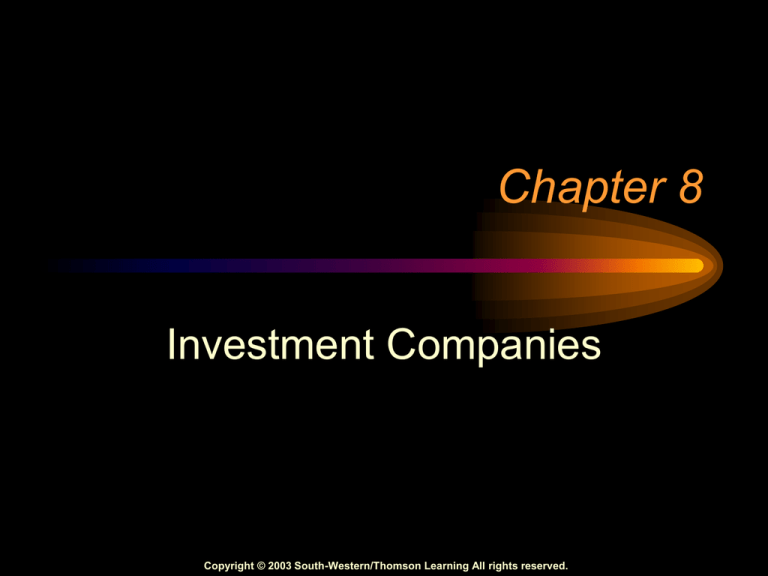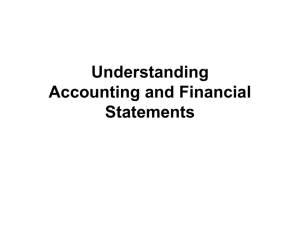
Chapter 8
Investment Companies
Copyright © 2003 South-Western/Thomson Learning All rights reserved.
Investment Companies
Two Types
• Closed-end
• Open-end (commonly called a
mutual fund)
Copyright © 2003 South-Western/Thomson Learning. All rights reserved.
Important General Information
• Net asset value (NAV) - the value
of a share
• Taxation - pass through vehicles
• Professional management
• Portfolio diversification
• Growth in mutual funds
Copyright © 2003 South-Western/Thomson Learning. All rights reserved.
Closed-end Investment
Companies
• Have a fixed capital structure
• Shares are bought and sold in the
secondary markets
• Shares may sell for a premium or
discount from NAV
• Tendency for shares to sell at a
discount from NAV
Copyright © 2003 South-Western/Thomson Learning. All rights reserved.
Sources of Return to the
Investor
• Income distributed in the form of
dividends
• Capital gains distributions
• Appreciation in the NAV
• Change in the discount/premium
Copyright © 2003 South-Western/Thomson Learning. All rights reserved.
Open-end Investment
Companies - Mutual Funds
• Have a variable capital structure
• Shares are bought and sold from
the mutual fund
• Shares cannot sell for a discount
from NAV
Copyright © 2003 South-Western/Thomson Learning. All rights reserved.
The Load Fee
• Charged to investor when the
shares are purchased
• Compensates the sales person
(i.e., is analogous to brokerage
commissions for buying securities)
Copyright © 2003 South-Western/Thomson Learning. All rights reserved.
The Load Fee
• Varies with dollar amount
purchased
• Load expenses mean investors pay
a premium over the fund's NAV
Copyright © 2003 South-Western/Thomson Learning. All rights reserved.
No-load Mutual Fund
• Mutual fund without a sales charge
Copyright © 2003 South-Western/Thomson Learning. All rights reserved.
Other Fees and Expenses
• Early withdrawal fees (or exit fees)
• Management fees
• Operating expenses
• 12b-1 fees
Copyright © 2003 South-Western/Thomson Learning. All rights reserved.
Mutual Fund Portfolios
• May be classified by
–type of investment
–investment style
Copyright © 2003 South-Western/Thomson Learning. All rights reserved.
Types of Investments
•
•
•
•
•
Growth funds
Balanced funds
Income funds
Growth and income funds
Specialized funds
Copyright © 2003 South-Western/Thomson Learning. All rights reserved.
Specialized Funds
•
•
•
•
•
•
Sector funds
Bond funds
Index funds
Tax-exempt bond funds
Single country or regional funds
Exchange - traded - funds
Copyright © 2003 South-Western/Thomson Learning. All rights reserved.
Investment Styles
•
•
•
•
•
Large cap
Mid-size cap
Small cap
Growth
Value
Copyright © 2003 South-Western/Thomson Learning. All rights reserved.
Capitalization
• Total market value of a company’s
stock
Copyright © 2003 South-Western/Thomson Learning. All rights reserved.
Growth
• A strategy designed to identify
companies that offer exceptional
opportunity for capital appreciation
Copyright © 2003 South-Western/Thomson Learning. All rights reserved.
Value
• A strategy designed to identify
companies whose stock price
appears to be below some estimate
of the firm's intrinsic value
• Stocks that are undervalued
Copyright © 2003 South-Western/Thomson Learning. All rights reserved.
Advantages Offered by Funds
• Diversification
• Professional management
• Custodial and other services
Copyright © 2003 South-Western/Thomson Learning. All rights reserved.
Returns
• Advantages do not necessarily
include superior returns
• Tendency to underperform the market
• Returns in an efficient market context
Copyright © 2003 South-Western/Thomson Learning. All rights reserved.
Factors that Affect Returns
• Expenses
• Fees
–load fees and exit fees
–12b-1 fees
• Movements in the market
Copyright © 2003 South-Western/Thomson Learning. All rights reserved.
Before and After - Tax Returns
• Fund returns are before tax
• Shareholders pay applicable taxes
• Shareholders realize after-tax
returns
Copyright © 2003 South-Western/Thomson Learning. All rights reserved.
Performance Evaluation
• CAPM as a theoretical basis for
comparison
• Market benchmark used in the
CAPM is often the S&P 500 stock
index
Copyright © 2003 South-Western/Thomson Learning. All rights reserved.
Performance Evaluation
Copyright © 2003 South-Western/Thomson Learning. All rights reserved.
Performance Evaluation
• Figure indicates the return that
should be earned for each level of
risk
Copyright © 2003 South-Western/Thomson Learning. All rights reserved.
Composite Performance
Measures: The Jensen Index
• a = rp - [rf + (rm - rf) beta]
• The alpha measures whether the
actual return exceeds the return
that should have been earned
based on the CAPM
Copyright © 2003 South-Western/Thomson Learning. All rights reserved.
The Composite Performance
Measures: The Treynor Index
• rp - rf
beta
• Standardizes the return in excess
of the risk-free return by the
portfolio's beta
Copyright © 2003 South-Western/Thomson Learning. All rights reserved.
The Composite Performance
Measures: The Treynor Index
• Uses the portfolio's volatility as the
measure of risk
• Assumes that the portfolio is well
diversified, so the beta (which
measures systematic risk only) is
the appropriate measure of risk
Copyright © 2003 South-Western/Thomson Learning. All rights reserved.
The Composite Performance
Measures: The Sharpe Index
• rp - rf
standard deviation
• Standardizes the return in excess
of the risk-free return by the
portfolio's standard deviation
• Uses the portfolio's variability as
the measure of risk
Copyright © 2003 South-Western/Thomson Learning. All rights reserved.
The Composite Performance
Measures: The Sharpe Index
• Does not assume that the portfolio
is well diversified
• Standard deviation (which
measures total risk) is the
appropriate measure of risk
Copyright © 2003 South-Western/Thomson Learning. All rights reserved.
Comparing Realized Returns
to Market Returns
Copyright © 2003 South-Western/Thomson Learning. All rights reserved.
Comparing Realized Returns
to Market Returns
• If the realized return lies above the
security market line, performance
exceeded the market return on a riskadjusted basis
• If the realized return lies below the
security market line, performance was
inferior to the market return on a riskadjusted basis
Copyright © 2003 South-Western/Thomson Learning. All rights reserved.
Comparing Realized Returns
to Market Returns
• Absolute returns do not necessarily
indicate inferior or superior returns
(Compare points X and Y)
Copyright © 2003 South-Western/Thomson Learning. All rights reserved.
The Benchmark Problem
• The comparisons use an aggregate
measure of the market
• The composition of many portfolios
are not comparable to the market
• Examples would be specialized
funds or global funds
Copyright © 2003 South-Western/Thomson Learning. All rights reserved.







